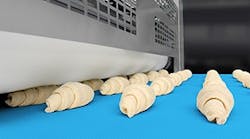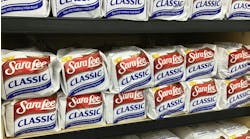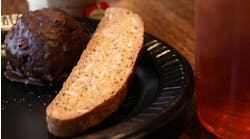Baking and automation just don’t seem like they would go together.
Baking is usually a batch process, often with significant time lags between steps like proofing and the oven. Most dough is too viscous to flow easily. And many higher-end baked goods have an artisan cachet that may seem incompatible with automation.
But automation has made steady inroads into many phases of industrial baking. And, as in all product segments, advances in aspects like robotics and digital technology have the potential to intensify the degree of automation.
“This is a great time to be in the baking industry,” says John Giacoio, vice president of sales for Rheon USA, which makes a range of dough forming and handling equipment. “Bakers are demanding better products, and this pushes equipment manufacturers to offer better equipment even before the customer knows it can be done. It is exciting to be able to provide a solution to a customer when they have all but given up on improvement.”
This system from Rheon uses a vision system to identify the tails of croissants coming from the sheeter and make adjustments.
Unsurprisingly, automation is more prevalent in larger, high-volume baking operations. But smaller ones are starting to see the advantages, says Gary Seiffer, sales specialist with EnSight Solutions, which makes a variety of processing and material handling equipment for bakeries and other sectors.
“There still are a lot of small bakers out there that want to grow, and if they’re smart, they’ll grow with machinery,” Seiffer says. This applies even to artisan bakers, some of whom continue to resist the idea of automation on the grounds of integrity, he says. “There are artisan bakers who say, ‘I’m never putting anything more than an oven and a mixer in my bakery. Anything more than that is automation, and that’s gonna kill my product.’ Well, it’s not.”
Automation is not just a matter of volume. “Part of the automation was not just to automate, but also to gain consistency,” Seiffer continues. Manual production of baked goods can lead to variations in individual products, for instance with loaves of bread being molded inconsistently, as Seiffer saw when he had a small bakery. “You would have what appeared to be two different loaves of bread because somebody didn’t want to do their job.”
That’s why dough dividing and molding became some of the first tasks in baking to be automated, especially in the artisan bread market.
“This type of product requires extensive hand work to preserve the handmade quality and look of the product,” Giacoio says. “We often find small to medium bakeries scaling artisan breads by hand to preserve cell structure. Many times this dough has high water content and long floor time, so even hand scaling and forming is difficult. Our stress-free dividers can handle long floor time dough with high hydration even better than can be done by hand.”
First steps
While dough dividing and other steps have been automated for decades, there are still many small bakeries that are just beginning to automate them. When operations like that achieve enough growth to require a significant production increase, the transition can be difficult.
A lot of bakery equipment, like this depositer from Unifiller, is on wheels to allow it to be used on multiple lines.
“For smaller food company operations, having their product picked up by a grocery chain or supporting a special promotion quickly means adjusting production for sudden increases in demand or short batch runs,” says Sonia Bal, director of marketing at Unifiller. “Hiring additional staff, paying more and covering additional benefits may not be feasible.”
Unifiller specializes in depositing equipment, for toppings and fillings. Depositing is a task that many bakers do by hand, since it’s a relatively delicate operation that demands precision and often entails product or ingredient changes.
“Unifiller equipment helps bakery and food producers move from manual to semi-automatic filling (or fully automated) in order to increase production yield, create better product consistency, reduce product waste and meet labeling requirements,” Bal says. “Our equipment is great for depositing and filling batters, buttercreams, dressings, dips, jams, sauces, relish, peanut butter, creams and more.”
Less specialized tasks are even more amenable to automation, which becomes more attractive in a tight labor market.
“For specialty bakeries that run semi-automated proofing and/or retarding lines, we have seen an increase in interest in automated rack loading and unloading,” says Mark Rosenberg, CEO of Gemini Bakery Equipment Co. “Due to a continued shortage of available labor/workers, we have seen an increase in need to eliminate and/or reduce the quantity of employees needed to manually load and unload racks.” Some Gemini systems can reduce up to five workers per shift, Rosenberg says.
Of course, automation is often used to speed up and increase throughput on an existing process.
“We see more opportunities for people to increase the capacity of a roll or bread line compared to clients building brand new lines,” Rosenberg says. “It is common that clients add new products that can run at a higher speed through their proofer and ovens and even packaging. The cost, and more importantly the potential downtime, is much less to upgrade a make-up line than to replace an entire production line.”
However, Seiffer cautions, there are some baked goods that just can’t be rushed, no matter how much automation gets added.
“In commercial baking, you need to keep things moving, but if the bread takes 20 minutes to bake, it takes 20 minutes to bake,” he says. Trying to make it run either faster or slower can hurt the product. In certain formulations, Seiffer suggests, electronics can be useful for keeping track of stages in dough development, for instance if dough needs to go into the oven no later than 20 minutes after it’s mixed.
Adapting technology
Certain technologies have the potential to greatly increase quality and consistency of baked goods, including servomotors, checkweighing, vision systems and robotics, the last two often combined. These have been around a long time, but their use in baking – at least, on the processing side – has been lagging.
For instance, robots combined with cameras form the basis for an EnSight system that debuted at this year’s IPPE show. (That show is mostly dedicated to meat and poultry, an area in which EnSight also works, but the technology can be used for baked goods.) The system, whose name was not released at press time, can look for misshapen light products like rolls and blow them off the belt with an air jet.
Vision also forms the basis for a high-speed croissant system from Rheon. “The system includes a vision system to identify the tail position, and makes adjustments automatically at speeds of 200 pieces per minute per row,” Giacoio says. “This is an unheard-of speed for the industry, and we take it one step further with the vision system.”
Servomotors bring to bakery equipment the advantages they confer on other high-speed processing and, especially, packaging equipment: precision and flexibility. Unifiller, for example, uses servos on some of its cake-decorating, depositing and other equipment.
“The servo-operated machines are designed for a host of benefits, bringing convenience and efficiency to any food manufacturer,” Bal says. “Easy-to-use, programmable touchscreen controls and a built-in ability to act as a slave to an automated conveyor-based production system add further efficiency.”
Checkweighers have been a staple of packaging systems, in bakeries and elsewhere, for decades. But their use with dough is relatively new. A big advantage with large goods like bread loaves is that they can ensure that the finished product will be of uniform weight, even though it may not be uniform size.
“Our stress-free dividers can handle long floor time dough with high hydration even better than can be done by hand,” Giacoio says. “They use an integrated loadcell under the conveyor that scales and cuts the dough piece to the required weight. Because we are cutting by weight the dough pieces may be different sizes, especially as the dough continues to proof out, but we are able to give a consistent weight with an artisan look.”
Using checkweighers on dough chunks also makes it possible to remove and rework the ones that are too far off weight, Seiffer says. If a finished and packaged loaf, roll, etc. is too far off weight, there’s nothing to do but throw it out.
Checkweighers also can combine with digital controls for corrective feedback loops. That’s an option with equipment from Hinds-Bock, a supplier of filling and depositing equipment, says Rod Gregg, executive vice president.
“PLCs on filling equipment can interface with electronic scales to check-weigh deposits coming off the filler. If the filler is equipped with automatic stroke adjustment, the upstream or downstream scale equipment can send a signal and the filler will adjust weights accordingly,” Gregg says.
Reiser’s Vemag 715 Process Check checkweigher (left) can work with a dough divider to both automatically correct dough portions and record long-term production trends.
Checkweighing can be used not only to ensure target weights for individual products, but to detect long-term efficiency trends, says John McIsaac, vice president of strategic business development for Reiser. Reiser’s Vemag Process Check VPC715 is a checkweigher that, along with regulating the action of its Vemag filler/depositor/sheeter equipment, can feed production historical data into manufacturing supervisory software.
“Payback is quick as it steers the divider to the correct weight as the product changes,” McIsaac says. “However, more and more of our customers are using it as data drivers to not only minimize giveaway, but track uptime and line efficiency.”
Walk first, then run
There can always be too much of a good thing, and automation is no exception. It’s often a good idea to introduce automation in stages, especially when slow batch steps have to synch up with faster ones downstream, which is often the case in baking.
“I spend sometimes as much time talking people out of automation as I do into automation,” says Ty Sarajian, president of Axis Automation, a supplier of fillers, depositors and other bakery equipment.
A recent Axis client was introducing to the market a small baked product injected with filling. This line was intended to run considerably faster than the customer’s existing ones, and the customer’s original thought was to use robots to place the product at the head of the line.
“I was quick to point out that we could find a way to do this in a manual fashion that would make it possible to go back and add a pick-and-place system later,” Sarajian says.
The end of the line presented another challenge. The bagging equipment ran faster than the injection line – when it ran. It went down frequently, which made it hard to coordinate with the equipment upstream.
Axis solved the problem by installing a spiral conveyor as a buffer between injecting and packaging. The conveyor holds up to 30 minutes’ worth of production and can be sped up to keep the bagger working while it’s up.
Timing the batches
That case is an example of one of the biggest challenges in food packaging generally: a disconnect between batch-oriented processing equipment and continuous, high-speed packaging equipment. This often is especially pronounced in baking, where many batches take a long time, and that time can vary between products.
That makes adequate accumulation capacity important, says Hugh Crouch, product manager at Harpak-Ulma. “That’s why your upstream distribution system and your feeding systems are able to handle and accumulate products, so you’re not doing the stop-and-start,” Crouch says. "But when you do need to run faster, your accumulation systems and your distribution systems can ramp up for those higher speeds."
Bakers are also seeing the same packaging trend as many other food processors: a demand for more SKUs, especially single-serve sizes. That means changeovers, which most processors do by hand. Pushbutton changeovers are the ideal, but Crouch admits that right now, these are easier for secondary packaging equipment like cartoners and case packers than for primary equipment like flowrappers.
“We build it into the cartoning systems – a lot of them today are one-button changeover,” Crouch says. “But in the flow wrap, it has not quite gotten to that point yet. But I believe in the future you’ll have equipment where you can have a range of products that you need to change over to, and you can have a recipe set up for it.”
For various reasons, many industrial bakers have been slow to embrace automation. But those that do will find that the right equipment can make their product better, as well as faster.
“This technology is out there,” Seiffer says. “The more consistent you can get with your bakery, the better you’re going to be at producing a profitable business.”


